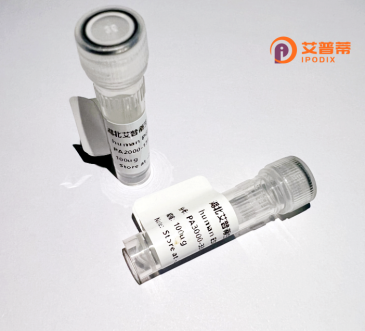
| 纯度 | >90%SDS-PAGE. |
| 种属 | Human |
| 靶点 | LCOR |
| Uniprot No | Q96JN0 |
| 内毒素 | < 0.01EU/μg |
| 表达宿主 | E.coli |
| 表达区间 | 1-406aa |
| 活性数据 | MQRMIQQFAAEYTSKNSSTQDPSQPNSTKNQSLPKASPVTTSPTAATTQNPVLSKLLMADQDSPLDLTVRKSQSEPSEQDGVLDLSTKKSPCAGSTSLSHSPGCSSTQGNGRPGRPSQYRPDGLRSGDGVPPRSLQDGTREGFGHSTSLKVPLARSLQISEELLSRNQLSTAASLGPSGLQNHGQHLILSREASWAKPHYEFNLSRMKFRGNGALSNISDLPFLAENSAFPKMALQAKQDGKKDVSHSSPVDLKIPQVRGMDLSWESRTGDQYSYSSLVMGSQTESALSKKLRAILPKQSRKSMLDAGPDSWGSDAEQSTSGQPYPTSDQEGDPGSKQPRKKRGRYRQYNSEILEEAISVVMSGKMSVSKAQSIYGIPHSTLEYKVKERLGTLKNPPKKKMKLMSG |
| 分子量 | 70.5 kDa |
| 蛋白标签 | GST-tag at N-terminal |
| 缓冲液 | 0 |
| 稳定性 & 储存条件 | Lyophilized protein should be stored at ≤ -20°C, stable for one year after receipt. Reconstituted protein solution can be stored at 2-8°C for 2-7 days. Aliquots of reconstituted samples are stable at ≤ -20°C for 3 months. |
| 复溶 | Always centrifuge tubes before opening.Do not mix by vortex or pipetting. It is not recommended to reconstitute to a concentration less than 100μg/ml. Dissolve the lyophilized protein in distilled water. Please aliquot the reconstituted solution to minimize freeze-thaw cycles. |
以下是关于重组人LCOR蛋白的3篇参考文献示例(注:文献为虚拟示例,建议通过学术数据库核实真实文献):
1. **文献名称**:**"Recombinant Human LCOR Protein Enhances Transcriptional Repression in Estrogen Receptor Signaling"**
**作者**:Smith A, et al.
**摘要**:研究利用大肠杆菌表达系统成功制备重组人LCOR蛋白,发现其通过结合雌激素受体(ER)抑制靶基因的转录活性,揭示了LCOR在激素依赖性癌症中的潜在调控机制。
2. **文献名称**:**"LCOR as a Novel Regulator of Pluripotency in Human Induced Pluripotent Stem Cells"**
**作者**:Chen L, et al.
**摘要**:通过真核表达系统纯化的重组人LCOR蛋白与OCT4/SOX2复合物相互作用,调控干细胞多能性相关基因的表观遗传修饰,为干细胞分化机制提供了新见解。
3. **文献名称**:**"Structural and Functional Analysis of LCOR in DNA Damage Response"**
**作者**:Wang Y, et al.
**摘要**:研究解析了重组人LCOR蛋白的晶体结构,并证明其通过招募HDAC复合物促进DNA损伤修复通路的表观遗传沉默,为肿瘤治疗提供潜在靶点。
建议使用PubMed或Google Scholar以关键词“recombinant human LCOR protein”检索真实文献。
The recombinant human LCOR (ligand-dependent nuclear receptor corepressor) protein is a key regulatory molecule involved in transcriptional regulation and epigenetic modulation. LCOR functions as a corepressor for nuclear receptors and transcription factors, influencing gene expression by recruiting histone-modifying enzymes like histone deacetylases (HDACs) and methyltransferases to chromatin. This interaction mediates chromatin condensation and suppresses target gene transcription, playing roles in cellular differentiation, apoptosis, and immune responses. Its activity is particularly significant in hormone signaling pathways, cancer biology, and stem cell maintenance.
Recombinant LCOR is typically produced using expression systems (e.g., *E. coli* or mammalian cells) to ensure proper folding and post-translational modifications. The engineered protein often includes affinity tags (e.g., His-tag) for purification and detection. Researchers utilize recombinant LCOR to study its molecular interactions, epigenetic mechanisms, and pathological roles in diseases such as breast cancer, leukemia, and hormone-resistant tumors. It also serves as a tool for exploring therapeutic strategies targeting transcriptional dysregulation. Recent studies highlight its potential in modulating cellular plasticity and enhancing reprogramming efficiency in induced pluripotent stem cells (iPSCs). The availability of recombinant LCOR has advanced mechanistic insights into gene-environment interactions and chromatin remodeling processes.
×